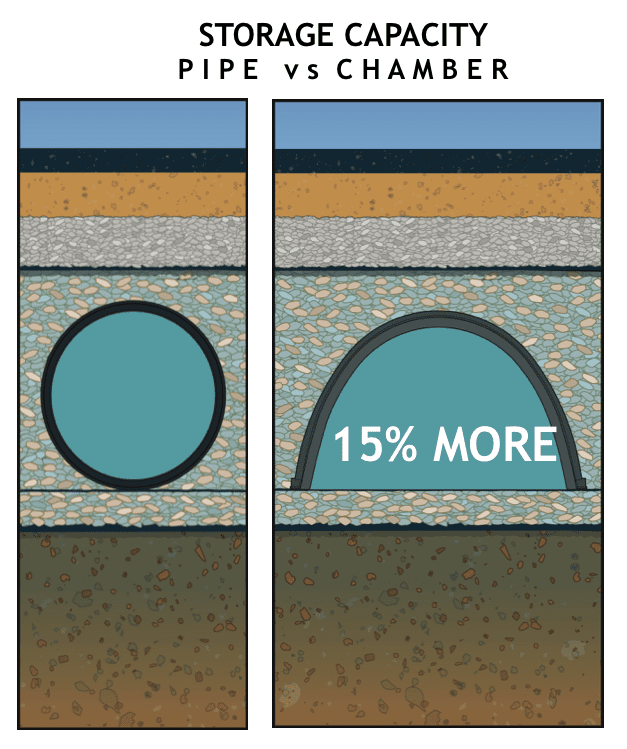Guest Column: Stormwater Chambers Provide Storage & Infiltration While Aiding in Recharge
July 8, 2015
Prinsco’s Director of Engineering, Carl Douglass, was published in national magazine Informed Infrastructure with an article titled, “Stormwater Chambers Provide Storage and Infiltration While Aiding Recharge.”
Click here to find it on their website or read it in full, below.
###
Stormwater Chambers Provide Storage and Infiltration While Aiding Recharge
by Carl Douglass, Prinsco Director of Engineering
Effective stormwater management and discharge continues to become more important as an increasing amount of land is covered by impervious surfaces due to residential and commercial development. Such conversion of land use, along with increasing regulatory requirements on water quality and quantity, creates critical considerations that must be addressed.
If a project requires a stormwater-management solution, it’s important to understand the choices and how they can help solve the specific problems faced. This column discusses stormwater chambers as an underground storage option that provides highly effective storage, recharge and infiltration.
Plastic Performs
Plastic stormwater chambers have been around for more than 15 years, with significant advancements in size and technology happening more recently. Chambers have become a trusted, high-performance component used as a stormwater best-management practice (BMP) in more-diverse applications than ever before.
First, the normal hydrologic cycle is disrupted when impervious surfaces replace trees, brush and soil. If precipitation can’t infiltrate the area where it lands, it creates a surge of runoff water, causing a deficit of water to recharge the water table and replenish regional aquifers.
Second, stormwater runoff from paved surfaces in urbanized areas collects debris and sediment that compromise water quality. Arched, open-bottom stormwater chambers can be a critical component of a stormwater-management system and help solve these problems.
Arch Advantage
Arch structures have been used for several thousand years and have proven to be a robust structural geometry, and they perform incredibly well for underground storage and dispersion of stormwater. The stormwater design community has long recognized this fact, and as the size of stormwater chambers increased, the industry responded by expanding and developing more-stringent American Society for Testing and Materials (ASTM) standards to ensure adequate baseline performance measures for product acceptance.
The two primary standards governing stormwater chambers are ASTM F2418 <I>Standard Specification for Polypropylene (PP) Corrugated Wall Stormwater Chambers<I> and ASTM F2787 <I>Standard Practice for Structural Design of Thermoplastic Corrugated Wall Stormwater Collection Chambers<I>. ASTM F2418 is a product standard developed to ensure the quality of the chambers, and ASTM F2787 is a design standard developed to ensure that the structural capacity of polypropylene chambers exceeds the application requirements and provides an extended design life. Together, these are the only two nationally recognized standards that govern polypropylene arch-shaped stormwater chambers and should be heavily relied upon for baseline product acceptance.

Beyond that, arched-shaped chambers can provide greater water storage efficiency than traditional circular pipe or other buried retention structures. For example, an installed 45-inch-tall chamber provides up to 15 percent more storage capacity per linear foot than a 48-inch-diameter perforated pipe, resulting in the chamber system with a 5 percent smaller footprint than the 48-inch pipe system. Most of this increased volume is gained within the chamber walls due to its unique design.
In terms of increased infiltration and recharge, the open chamber bottom allows uninhibited water flow into the aggregate embedment below. This promotes maximum infiltration rate and better groundwater recharge, particularly for areas where soil conditions allow for rapid percolation.
Tailored for Treatment
Chambers are used as part of a total solution that includes water-quality treatment, because stormwater runoff from urbanized areas collects debris and sediment, requiring water-treatment BMPs tailored for the regional requirements and expected contaminant loading. This is true for above-ground ponds and buried retention systems, and it’s especially true for underground systems such as chambers that rely on voids within the aggregate for water storage.
Pre-treatment devices are critical and ensure maximum system service life and environmental protection by preventing stone clogging and the collection of contaminants before storage and infiltration.
Stormwater chamber systems also are extremely flexible, making it easy to tailor them to any best-management practice to ensure adequate water treatment for specific application conditions and regulations.
Although every project has different circumstances and requirements, chamber systems can serve the widest range of stormwater applications in the market today. They’re highly configurable, easy to install, cost effective and comparable to other underground stormwater -retention products. Their simple, unique design provides high storage capacity with the potential for maximum groundwater recharge and water filtration.
